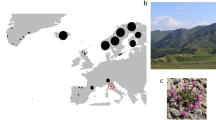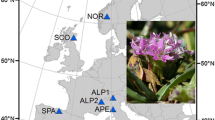Abstract
Management of seed banks conserving the biodiversity of phylogenetically diverse species requires insight into seed longevity. This study determined the seed longevity of 172 species sourced from across the mega-diverse flora of the Australia continent. Seeds were aged via a controlled ageing experiment through storage at 45 °C and 60 % RH, or 60 °C and 60 % RH, and regularly tested for germination. Relative seed longevity between species was determined by comparing the time to 50 % viability loss (p 50), calculated via probit analysis of seed survival curves. Seed, plant, and environmental traits were examined for associations with longevity. The p 50 values varied between species from 3.0 to 588.6 days. Serotinous species, and woody trees and shrubs, had significantly longer-lived seeds than geosporous species, and species of herbaceous habit. Seeds that possess physical dormancy, and seeds with large embryos with little endosperm, were also long-lived. There was a weak, but significant, positive correlation between seed mass and longevity. Seeds sourced from regions of higher mean annual temperature and rainfall were significantly longer-lived than seeds from cooler and drier regions, although both environmental factors were weakly associated with longevity. Compared with species from other regions of the world, prolonged longevity is a feature of many Australian species. Nevertheless, seed life-spans vary substantially between species and close consideration of seed traits along with biotic and abiotic components of the plants and their environment can assist to differentiate between potentially long- and short-lived seeds.







Similar content being viewed by others
References
APGIII (2009) An update of the Angiosperm Phylogeny Group classification for the orders and families of flowering plants: APG III. Bot J Linn Soc 161:105–121
Clarke PJ, Knox KJE, Butler D (2011) Fire intensity, serotiny and seed release in 19 woody species: evidence for risk spreading among wind-dispersed and resprouting syndromes. Aust J Bot 58:629–636
Colville L, Bradley EL, Lloyd AS, Pritchard HW, Castle L, Kranner I (2012) Volatile fingerprints of seeds of four species indicate the involvement of alcoholic fermentation, lipid peroxidation, and Maillard reactions in seed deterioration during ageing and desiccation stress. J Exp Bot 63:6519–6530
Crawford AD, Plummer JA, Probert RJ, Steadman KJ (2011) The influence of cone age on the relative longevity of Banksia seeds. Ann Bot-London 107:303–309
Crawley MJ (2007) The R book. John Wiley, Chichester
Ellis RH, Roberts EH (1980) Improved equations for the prediction of seed longevity. Ann Bot-London 45:13–30
FAO (2013) Genebank standards for plant genetic resources for food and agriculture. Food and Agriculture Organization of the United Nations, Rome
Fitzpatrick MC, Gove AD, Sanders NJ, Dunn RR (2008) Climate change, plant migration, and range collapse in a global biodiversity hotspot: the Banksia (Proteaceae) of Western Australia. Global Change Biol 14:1337–1352
Flematti GR, Ghisalberti EL, Dixon KW, Trengove RD (2005) Synthesis of the seed germination stimulant 3-methyl-2H-furo [2, 3-c] pyran-2-one. Tetrahedron Lett 46:5719–5721
Forbis TA, Floyd SK, Ad Queiroz (2002) The evolution of embryo size in angiosperms and other seed plants: implications for the evolution of seed dormancy. Evolution 56:2112–2125
Godefroid S, Riviere S, Waldren S, Boretos N, Eastwood R, Vanderborght T (2011) To what extent are threatened European plant species conserved in seed banks? Biol Conserv 144:1494–1498
Hay FR, Probert RJ (2013) Advances in seed conservation of wild plant species: a review of recent research. Conserv Physiol 1:1–11
Hay F, Klin J, Probert R (2006) Can a post-harvest ripening treatment extend the longevity of Rhododendron L. seeds? Sci Hortic-Amsterdam 111:80–83
Hay FR, Adams J, Manger K, Probert R (2008) The use of non-saturated lithium chloride solutions for experimental control of seed water content. Seed Sci Technol 36:737–746
Hay FR, Merritt DJ, Soanes JA, Dixon KW (2010) Comparative longevity of Australian orchid (Orchidaceae) seeds under experimental and low temperature storage conditions. Bot J Linn Soc 164:26–41
Hopper SD, Gioia P (2004) The southwest Australian floristic region: evolution and conservation of a global hot spot of biodiversity. Annu Rev Ecol Evol Syst 35:623–650
House SM (1997) Reproductive biology of eucalypts. In: Williams J, Woinarski J (eds) Eucalypt Ecology: Individuals to Ecosystems. Cambridge University Press, Cambridge, pp 30–55
Kochanek J, Steadman KJ, Probert RJ, Adkins SW (2009) Variation in seed longevity among different populations, species and genera found in collections from wild Australian plants. Aust J Bot 57:123–131
Kranner I, Minibayeva FV, Beckett RP, Seal CE (2010) What is stress? Concepts, definitions and applications in seed science. New Phytol 188:655–673
Lamont BB, Le Maitre D, Cowling R, Enright N (1991) Canopy seed storage in woody plants. The Bot Rev 57:277–317
Li DZ, Pritchard HW (2009) The science and economics of ex situ plant conservation. Trends Plant Sci 14:614–621
Lindenmayer DB, Steffen W, Burbidge AA, Hughes L, Kitching RL, Musgrave W, Stafford Smith M, Werner PA (2010) Conservation strategies in response to rapid climate change: Australia as a case study. Biol Conserv 143:1587–1593
Mackey BG, Watson JEM, Hope G, Gilmore S (2008) Climate change, biodiversity conservation, and the role of protected areas: an Australian perspective. Biodiversity 9:11–18
Martin A (1946) The comparative internal morphology of seeds. Am Midl Nat 36:513–660
Merritt DJ, Dixon KW (2011) Restoration seed banks—a matter of scale. Science 332:424–425
Moles AT, Ackerly DD, Tweddle JC, Dickie JB, Smith R, Leishman MR, Mayfield MM, Pitman A, Wood JT, Westoby M (2007) Global patterns in seed size. Global Ecol Biogeogr 16:109–116
Mondoni A, Probert RJ, Rossi G, Vegini E, Hay FR (2011) Seeds of alpine plants are short lived: implications for long-term conservation. Ann Bot-London 107:171–179
Myers N, Mittermeier RA, Mittermeier CG, Da Fonseca GAB, Kent J (2000) Biodiversity hotspots for conservation priorities. Nature 403:853–858
Newton R, Hay F, Probert R (2009) Protocol for comparative seed longevity testing. Royal Botanic Gardens Kew, London
Orme D (2012) The caper package: comparative analysis of phylogenetics and evolution in R. http://caper.r-forge.r-project.org/
Parsons R (2012) Incidence and ecology of very fast germination. Seed Sci Res 22:161–167
Probert RJ, Daws MI, Hay FR (2009) Ecological correlates of ex situ seed longevity: a comparative study on 195 species. Ann Bot-London 104:57–69
Smith P, Dickie J, Linington S, Probert R, Way M (2011) Making the case for plant diversity. Seed Sci Res 21:1–4
Tuckett RE, Merritt DJ, Hay FR, Hopper SD, Dixon KW (2010) Comparative longevity and low-temperature storage of seeds of Hydatellaceae and temporary pool species of south-west Australia. Aust J Bot 58:327–334
Vandelook F, Janssens SB, Probert RJ (2012) Relative embryo length as an adaptation to habitat and life cycle in Apiaceae. New Phytol 195:479–487
Walters C, Wheeler LM, Grotenhuis JM (2005) Longevity of seeds stored in a genebank: species characteristics. Seed Sci Res 15:1–20
Zuur AF, Ieno EN, Walker N, Saveliev AA, Smith GM (2009) Mixed effects models and extensions in ecology with R. Springer, New York
Acknowledgments
The authors thank Sam Clarke, Todd Erickson, Lydia Guja, and Jessica Taylor for technical assistance. Gavin Flematti and Adrian Scaffidi (School of Chemistry and Biochemistry, UWA) synthesized the KAR1 used in this study. This research was supported in part by an Australian Research Council Linkage Grant (LP0455415) and was conducted under the auspices of the Millennium Seed Bank Project, Kew, which is supported by the UK Millennium Commission, the Welcome Trust and Orange plc.
Author information
Authors and Affiliations
Corresponding author
Additional information
Communicated by David Hawksworth.
Appendix
Rights and permissions
About this article
Cite this article
Merritt, D.J., Martyn, A.J., Ainsley, P. et al. A continental-scale study of seed lifespan in experimental storage examining seed, plant, and environmental traits associated with longevity. Biodivers Conserv 23, 1081–1104 (2014). https://doi.org/10.1007/s10531-014-0641-6
Received:
Revised:
Accepted:
Published:
Issue Date:
DOI: https://doi.org/10.1007/s10531-014-0641-6




